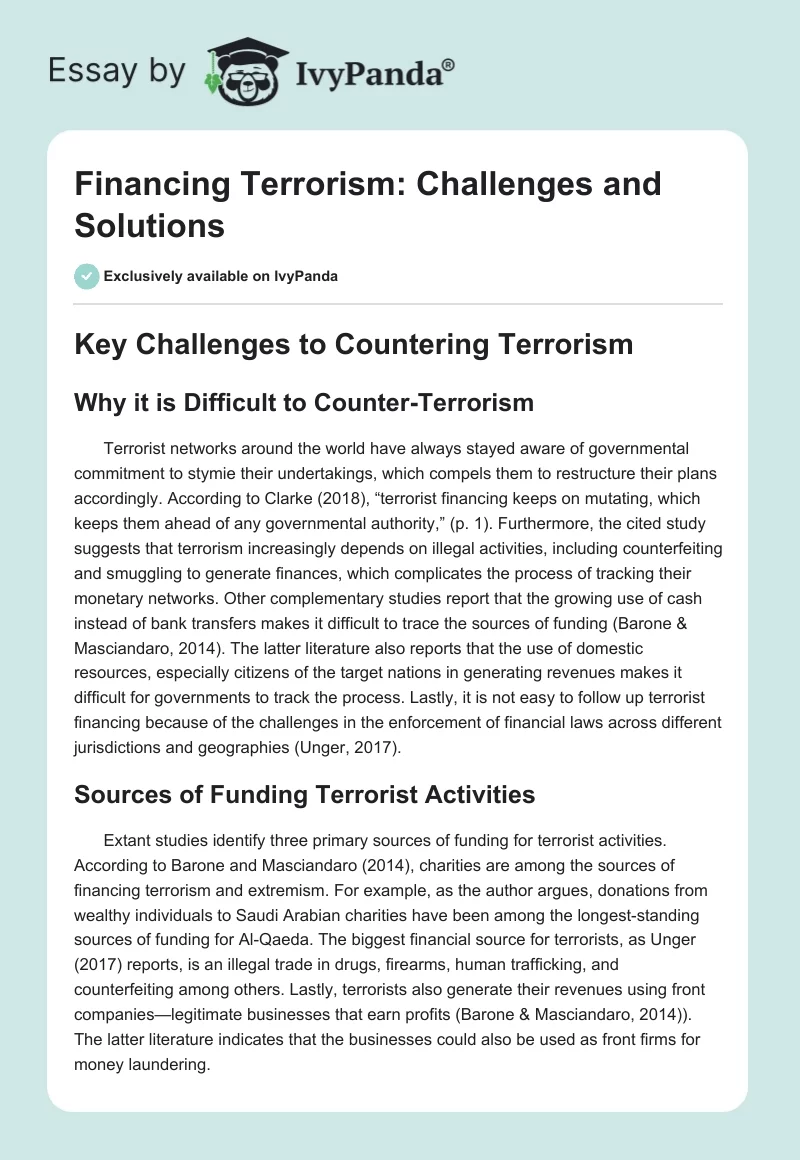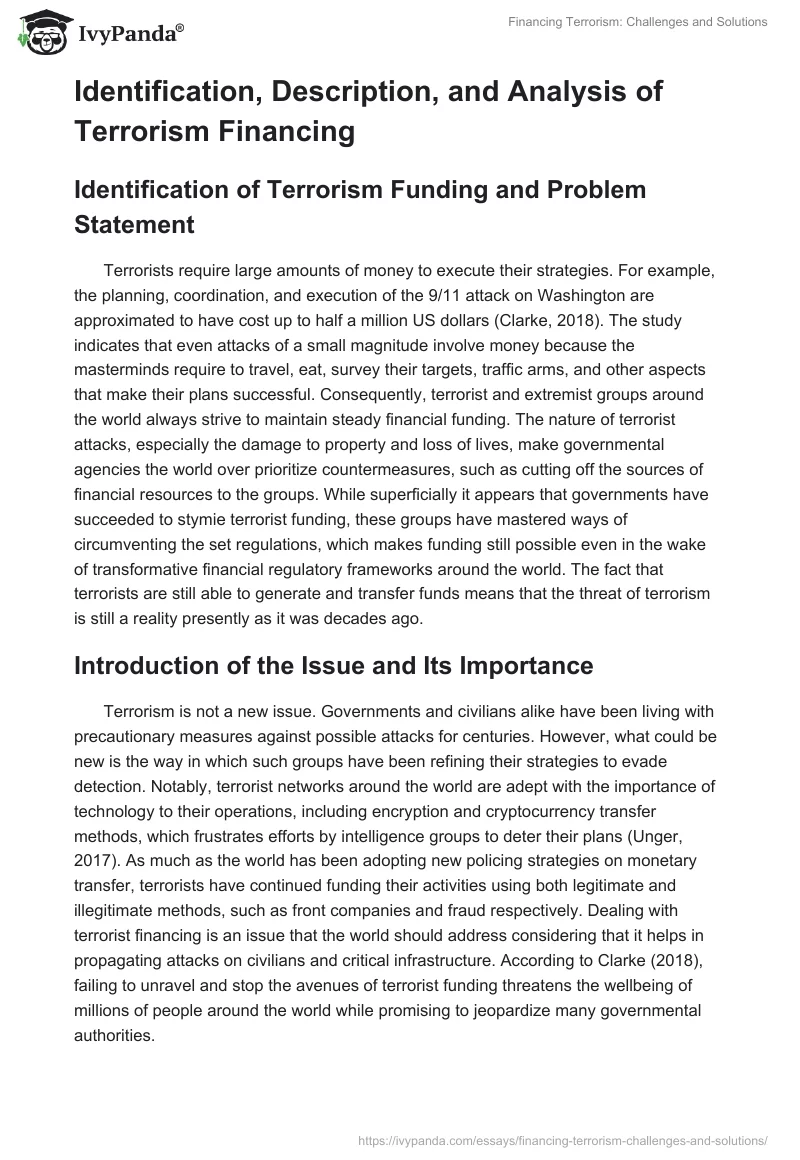Key Challenges to Countering Terrorism
Why it is Difficult to Counter-Terrorism
Terrorist networks around the world have always stayed aware of governmental commitment to stymie their undertakings, which compels them to restructure their plans accordingly. According to Clarke (2018), “terrorist financing keeps on mutating, which keeps them ahead of any governmental authority,” (p. 1). Furthermore, the cited study suggests that terrorism increasingly depends on illegal activities, including counterfeiting and smuggling to generate finances, which complicates the process of tracking their monetary networks. Other complementary studies report that the growing use of cash instead of bank transfers makes it difficult to trace the sources of funding (Barone & Masciandaro, 2014). The latter literature also reports that the use of domestic resources, especially citizens of the target nations in generating revenues makes it difficult for governments to track the process. Lastly, it is not easy to follow up terrorist financing because of the challenges in the enforcement of financial laws across different jurisdictions and geographies (Unger, 2017).
Sources of Funding Terrorist Activities
Extant studies identify three primary sources of funding for terrorist activities. According to Barone and Masciandaro (2014), charities are among the sources of financing terrorism and extremism. For example, as the author argues, donations from wealthy individuals to Saudi Arabian charities have been among the longest-standing sources of funding for Al-Qaeda. The biggest financial source for terrorists, as Unger (2017) reports, is an illegal trade in drugs, firearms, human trafficking, and counterfeiting among others. Lastly, terrorists also generate their revenues using front companies—legitimate businesses that earn profits (Barone & Masciandaro, 2014)). The latter literature indicates that the businesses could also be used as front firms for money laundering.
Identification, Description, and Analysis of Terrorism Financing
Identification of Terrorism Funding and Problem Statement
Terrorists require large amounts of money to execute their strategies. For example, the planning, coordination, and execution of the 9/11 attack on Washington are approximated to have cost up to half a million US dollars (Clarke, 2018). The study indicates that even attacks of a small magnitude involve money because the masterminds require to travel, eat, survey their targets, traffic arms, and other aspects that make their plans successful. Consequently, terrorist and extremist groups around the world always strive to maintain steady financial funding. The nature of terrorist attacks, especially the damage to property and loss of lives, make governmental agencies the world over prioritize countermeasures, such as cutting off the sources of financial resources to the groups. While superficially it appears that governments have succeeded to stymie terrorist funding, these groups have mastered ways of circumventing the set regulations, which makes funding still possible even in the wake of transformative financial regulatory frameworks around the world. The fact that terrorists are still able to generate and transfer funds means that the threat of terrorism is still a reality presently as it was decades ago.
Introduction of the Issue and Its Importance
Terrorism is not a new issue. Governments and civilians alike have been living with precautionary measures against possible attacks for centuries. However, what could be new is the way in which such groups have been refining their strategies to evade detection. Notably, terrorist networks around the world are adept with the importance of technology to their operations, including encryption and cryptocurrency transfer methods, which frustrates efforts by intelligence groups to deter their plans (Unger, 2017). As much as the world has been adopting new policing strategies on monetary transfer, terrorists have continued funding their activities using both legitimate and illegitimate methods, such as front companies and fraud respectively. Dealing with terrorist financing is an issue that the world should address considering that it helps in propagating attacks on civilians and critical infrastructure. According to Clarke (2018), failing to unravel and stop the avenues of terrorist funding threatens the wellbeing of millions of people around the world while promising to jeopardize many governmental authorities.
Discussion and Background to the Issue
Terrorists finance their activities both legitimately and illegitimately. Illicit trading activities are the primary sources of terrorist revenues. Primarily, terror groups around the globe involve in the illegal trading of weapons (armories are significant to the execution of attacks) drugs of abuse, such as cocaine, heroin, and marijuana, human trafficking, especially children and women, and others (Unger, 2017). As the latter literature indicates, illegal trade is so significant in the world that it is approximated that it constitutes up to ten percent of the global gross domestic product.
Charities are one of the legitimate ways through which terror organizations support their activities. In quantifying the contributions of charities to terror funding, Barone and Masciandaro (2014) suggest that at one time, donations were the most significant sources of funding to these groups. For example, the author indicates that charities and wealthy people in the Kingdom of Saudi Arabia have been the longest-serving and consistent source of financial support to al-Qaeda. Despite governmental efforts to thwart terrorism in the Kingdom, charities have increasingly played a critical role in terrorist funding.
Terror organizations also use front companies as an alternative source of funding. Notably, some terrorists start conventional businesses, which generate profits that they channel to other activities. In other cases, the companies are used to illegally earn money, especially through laundering. For instance, it is reported that Osama bin Laden owned and ran a chain of retail stores that sold honey and related products across the Middle East, especially in Pakistan (Clarke, 2018).
Three Potential Solutions
The reported challenges call for the need to prioritize strategies that will curb illegal money acquisition, especially through laundering. One of the ways of doing so is to deal with channels that aid in receiving such monies through legislation and restructuring of global money transfer systems (Barone & Masciandaro, 2014). Counter-terrorism measures could also be intensified to address funding for terrorist activities, primarily through enhancing intelligence. Lastly, the world should contemplate creating a system that allows all countries to share real-time information on terrorism as a means of improving awareness of the danger of such activities.
Conclusion and Recommendation
Terrorists are growingly becoming hard to identify, monitor, and apprehend because they keep updating their operational plans. Despite the world improving its legislation on financial issues, terrorists continue generating and transferring money that smoothens their activities, and they do so both legally and illegally. The challenge of understanding the way these groups develop, store, manage, and transfer their finances means that unless a better approach is adopted, millions of people in the world are at risk of terrorist attacks. This paper recommends the integration of terrorism information resources that will increase the way internal organizations and governments share real-time data on possible crimes.
References
- Barone, R., & Masciandaro, D. (2014). Organized crime, money laundering, and legal economy: theory and simulations. European journal of law and economics, 32(1), 115-142.
- Clarke, C. P. (2018). An overview of current trends in terrorism and illicit finance. Rand.org. Web.
- Unger, B. (2017). Money laundering-a newly emerging topic on the international agenda. Review of Law & Economics, 5(2), 807-819.


